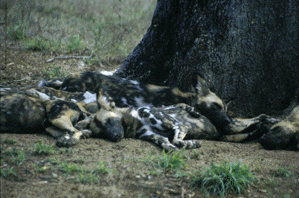Lowveld Wild Dog Project
 This page has been mothballed.
This page has been mothballed.
It is no longer being updated but we've left it here for reference.

 THE PACK
THE PACK
- Wild dogs are highly social animals that live in packs of between 2 and over 20 adults with their dependant young. Packs of over 40 wild dogs do occur occasionally although they don't last very long and tend to split up into smaller groups.
- A 'pack' is defined as having the potential to breed i.e. there must be at least one male and one female. Single sex aggregations of individuals are referred to as 'groups' and are not properly a pack until a member of the opposite sex joins them.
- Each pack has a dominant female, the 'alpha female', and a dominant male, the 'alpha male'. Together these two dogs are referred to as the 'alpha pair'. It is the alpha pair that determine the packs movements and are typically the only two wild dogs in the pack to breed (see 'Denning').
- Wild dogs are highly dependent upon the pack for survival. Being in a pack allows them to catch prey on a more regular basis and to share the energetic costs of hunting. It increases their effectiveness against competition and predation from lion and spotted hyaena and also increases the survival chances of their pups.
- It is interesting to note that in African wild dogs, no sex is consistently larger or dominates the other. Even within the alpha pair dominance can lie either with the male or the female. This situation where the sexes are so evenly matched is unusual within the animal kingdom.
- Members of a wild dog pack also get a form of health insurance by being part of a pack. When a pack member gets an injury that prevents it from taking an active role in hunting and other duties, instead of turning on the individual as would be expected from most animal species, the pack will typically look after the injured dog. If it can't make it to kills, other dogs in the pack will regurgitate meat for it until it is better.
- Dispersal away from a pack typically occurs when wild dogs that were born into the pack reach the age of between 1.5 to 3 years old. These wild dogs will leave the pack in groups. These groups typically consist of single sex aggregations of brothers or sisters from the same litter.
- Such groups may remain as single sex groups for over a year, depending on the availability of unrelated members of the opposite sex. They will sometimes travel huge distances, over 200km, in search of new areas and potential mates.
- A new pack is then formed when two of the single sex groups, one of males and the other of females meet and join up.

